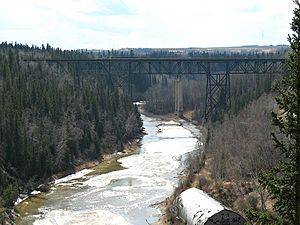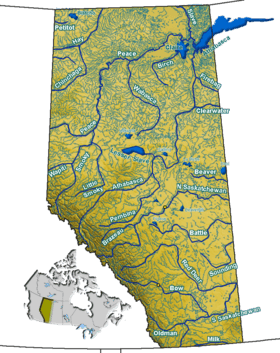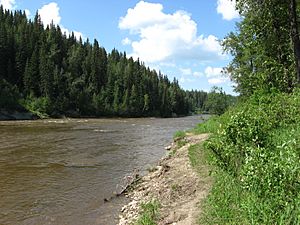Pembina River (Alberta) facts for kids
The Pembina River is a river in central Alberta, Canada. It flows into the larger Athabasca River. The name "Pembina" comes from Canadian French. It refers to a type of berry called the high bush cranberry (Viburnum trilobum). This river also gave its name to the Pembina oil field. This area near Drayton Valley is important for producing oil and gas. An environmental group, the Pembina Institute, also chose its name from this river.
Contents
Where Does the Pembina River Start and End?

The Pembina River begins in the Canadian Rockies foothills. This area is called Pembina Forks, south of Cadomin. The river flows east for about 547 kilometers (340 miles). It then joins the Athabasca River about 64 kilometers (40 miles) west of the town of Athabasca.
The area that drains into the Pembina River is very large. It covers about 12,900 square kilometers (4,981 square miles). Water from the Pembina River travels through many other rivers. Eventually, it reaches the Mackenzie River. From there, it flows all the way into the Arctic Ocean.
Communities Along the Pembina River
Several towns and communities are located along the Pembina River. These include Westlock, Sangudo, Entwistle, and Evansburg.
You can also find special protected areas along the river:
- The Pembina River Provincial Park is a beautiful place. It is located along the river's deep gorges between Evansburg and Entwistle.
- The Pembina River Natural Area is another protected spot. It is about 20 kilometers (12 miles) northeast of Cherhill. This area is known for its aspen parkland, which has many aspen trees.
What Rivers and Lakes Flow into the Pembina River?
Many smaller rivers and lakes flow into the Pembina River. These are called tributaries. Some of the main ones include:
- Rat Creek
- Bailey Creek
- Hanson Creek
- Crooked Creek
- Centre Creek
- Lovett River
- Bigoray River
- Mishow Creek
- Lobstick River (which includes water from Chip Lake)
- Coyote Lake Creek
- MacDonald Creek (which includes water from Lac la Nonne)
- Newton Creek
- Paddle River
- Wabash Creek
- Dapp Creek
- Shoal Creek
- Killsyth Creek
- Flatbrush Creek
Many small lakes also contribute water to the Pembina River's basin. These include Brock Lake, Oldman Lake, Majeau Lake, Lac la Nonne, George Lake, Armstrong Lake, Shoal Lake, Steele Lake, and Cross Lake.
See also
 In Spanish: Río Pembina para niños
In Spanish: Río Pembina para niños




